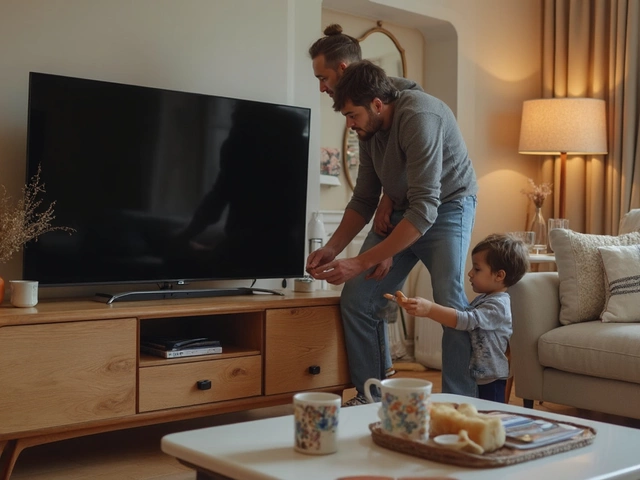 15
May,2025
15
May,2025
When you’re shopping for an office chair, it’s easy to get distracted by flashy colors or promises of ‘extra comfort.’ Skip the fluff for a second and think about this: how many hours do you spend sitting? An uncomfortable chair isn’t just a pain – it wrecks your back, kills your focus, and you end up shelling out for a new one way too soon.
If you want a chair that won’t fall apart or feel like a medieval torture device by day three, start by checking how solid it feels. Grab the armrests and give them a wiggle. If they creak or shift, that’s a red flag. Look for thick screws or metal bolts underneath, not just plastic snaps. A high-quality office chair feels steady, not flimsy.
Don’t rely on looks alone. Good chairs might look plain, but the work is in the details—like the way the seat holds up after you stand or how smoothly the wheels roll. If you can, push around on the casters, sit and shift your weight, and adjust the height a few times. Annoying squeaks, lopsided seats, or janky adjustments? Walk away.
- What Good Build Quality Really Looks Like
- Comfort: More Than Just a Soft Seat
- Materials That Make the Difference
- Smart Features Worth Paying For
What Good Build Quality Really Looks Like
If you want a chair that lasts, solid build quality is where you start. The best office chair frames almost always use steel or thick aluminum, not plastic. Older models made with wood frames can be sturdy, too, but they’re pretty rare these days. Just flip the chair over and check the base material—metal means business.
Next up, check the way joints connect. Loose hardware, wobbly screws, or plastic bolts usually mean cheap construction. Well-built models often use metal fasteners or machine-welded joints. One quick check: gently rock the seat or armrests. If there’s rattling or a lot of give, skip that chair.
The gas lift cylinder (that adjustable part under the seat) is another big deal. Trusted brands use class-4 or higher gas lifts, which are certified for heavy use and often last for years. Cheap chairs tend to use lower class cylinders, and those are the ones that droop or fail after a few months of daily use.
Wheels might seem like a small thing, but junk casters crack fast, especially if your office isn’t carpeted. Look for dual-wheel, polyurethane casters and a metal wheelbase. If the wheels feel gritty or don’t roll smooth when you try them, that’s a bad sign.
- Frame: Go for metal, not plastic.
- Joint connections: Metal fasteners beat plastic clips.
- Gas lift: Look for “class-4” or higher cylinders.
- Casters: Dual-wheel, polyurethane types hold up much better.
There’s no need to study a chair for an hour. Just flip it over, poke around, and use your hands. The parts that matter should all feel tight and tough, since flimsy construction always shows itself up close.
Comfort: More Than Just a Soft Seat
A lot of people think comfort just means a chair feels soft when you first sit down, but that’s only the start. Quality office chair comfort is about how you feel after a few hours. A real test: if you stand up at the end of the day and your back or neck hurts, you’ve got the wrong seat.
The best chairs are designed to support how bodies naturally sit and move. Look for lumbar support — that’s the bump or curve in the backrest that fits into your lower back. Harvard ergonomics experts back this up: lumbar support helps stop you from slouching and keeps the spine in alignment, so you’re less likely to end up with annoying aches.
Another thing that matters a ton is adjustability. Good chairs let you change the height, armrest position, recline, and even the tilt tension (how easy it is to lean back). This isn’t just fancy talk — being able to tweak these lets you dial the chair in for your own body, not just how the manufacturer thinks you should sit.
Don’t ignore seat depth and width. If the chair is too deep, you end up perched at the edge, which means zero support. Too narrow, and you feel squeezed. Ideally, there’s a couple of inches between the back of your knees and the seat edge. Also, breathable materials like mesh help you stay cool during long workdays, while memory foam in the right amount (not too squishy) keeps your butt from getting numb.
This stuff matters whether you’re at a fancy standing desk or stuck in Zoom meetings all day. When you’re trying a chair in-store, pay attention to how you sit naturally and see if your body feels relaxed and supported after ten minutes—not just the first two.

Materials That Make the Difference
The materials in your office chair are pretty much the main event—they separate the chairs that last from the ones that start peeling or sagging before your next work anniversary. The secret isn't in the fancy names, but in the facts: what holds up when you actually use the thing every day?
Let's break it down. Usually, you’ll run into three main types of materials for seats and backs: mesh, fabric, and leather (real or fake). Mesh is the king of breathability, which is why most high-end chairs use it for the backrest. If you sweat a lot at your desk, a mesh back just makes life way easier. But not all mesh is equal—cheap mesh stretches out and sags by month three. Look for thick, firm mesh that bounces back when you press on it.
Fabric is comfy and comes in all sorts of colors and patterns, but it can stain and grab onto lint and dust. On the plus side, it usually runs cooler than leather and doesn’t stick to your legs. Still, check if the seat cushion bounces back after pressing. Good foam should snap back instead of leaving an imprint of your hand.
Leather (and its cheaper cousin, PU or "pleather") is the go-to for that executive look. Real leather sticks around for years if you keep it clean, but fake leather cracks and peels after a year or two. If you want leather, be sure you’re getting the real thing—or at least a super-thick PU that won’t flake right away.
Now, let’s talk frames and moving parts. Steel or high-grade aluminum frames mean serious business, while plastic wears out fast in high-stress spots like the base or casters. Feel under the chair; metal parts feel cool to the touch, and you’ll usually spot shiny bolts at connection points. As for wheels, hard plastic is common, but look for rubber-coated ones if you’ve got wood or tile floors—they scratch less and roll smoother.
| Material | Average Lifespan | Common Issues |
|---|---|---|
| Mesh (high quality) | 5+ years | Sagging (if cheap), little support |
| Fabric | 3–7 years | Stains, faded colors, dust |
| Real Leather | 7–10 years | Cracks if not cleaned, costly |
| PU Leather | 1–3 years | Peeling, cracking |
| Metal Frame | 10+ years | Heavy, more expensive |
| Plastic Frame | 2–5 years | Cracks under pressure |
Tip: Check weight ratings, even if you don’t think you need them. Chairs rated for 250 lbs or higher are usually built better. If you want a chair that lasts, don’t just check the surface—dig into what’s underneath and what keeps it all together. That’s where the value really sits.
Smart Features Worth Paying For
It’s pretty frustrating when you splash out on a new office chair, then realize after a week that it’s missing some features you actually need. Modern office chairs aren’t just about looking professional—some have tech and little design tweaks that actually make a huge difference in comfort and long-term health.
First off, adjustable lumbar support is a big one. Not every chair lets you move the lower back support up or down. But when you can, it helps match the curve of your spine to the chair, which is a life-saver on long workdays. Look for this, especially if you have lower back pain or want to avoid it.
Height-adjustable armrests are another game-changer. Fixed armrests might feel fine for five minutes, but they can totally ruin your posture over hours. Being able to raise, lower, or even move armrests in and out lets you keep your shoulders relaxed and elbows bent right at 90 degrees—just like ergonomics experts recommend.
Tilt and recline functions are more useful than most people think. Chairs with a lockable tilt and adjustable tilt tension let you lean back comfortably or sit upright when you need to focus. Some chairs even have "dynamic synchro-tilt," where the seat and backrest move at different rates, which can help shift pressure and make long sessions more comfortable.
If you’re on video calls a lot, adjustable headrests can help too. They might look extra, but they support your neck, especially if you tend to lean back or hunch forward during meetings.
More high-end chairs also offer seat depth adjusters. This isn’t as common as it should be. If you’re tall or short, being able to slide the seat forward or back means you’ll avoid having your legs dangle or your knees crammed up. Check for this feature if multiple people will use the chair, or if you never seem to fit right in typical office chairs.
- Adjustable lumbar support – moves up/down or in/out for your back’s curve
- Height & width adjustable armrests – adapts to your desk, keeps posture on point
- Tilt and recline with lock/tension – supports both focus and downtime
- Adjustable seat depth – fits different heights and leg lengths
- Headrest adjustability – useful for neck support, especially during calls
Some chairs list a crazy number of adjustments, but make sure they’re not just for show. Test each one. Nothing’s more annoying than an armrest that “adjusts” and then jams after a month.
Want a quick view of which features are most common on quality chairs? Check out this simple table:
| Feature | Percentage of High-End Chairs* |
|---|---|
| Adjustable Lumbar Support | Nearly 90% |
| Adjustable Armrests | 80% |
| Tilt & Recline Lock | 85% |
| Seat Depth Adjustment | 65% |
| Headrest | 40% |
*Based on a comparison of top-rated chairs by a 2024 office products review site.
In short, don’t mindlessly tick boxes—pick features that really fit your work style and body. That’s how to know you’re paying for upgrades that matter, not just gimmicks.




